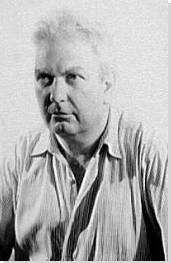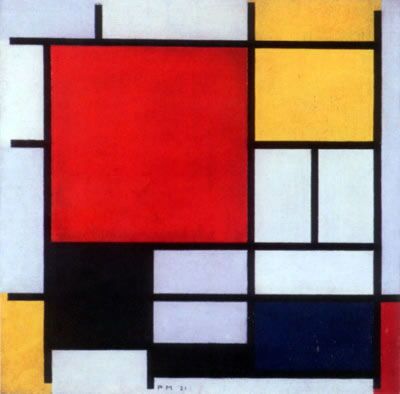Summary of Alexander Calder
American artist Alexander Calder redefined sculpture by introducing the element of movement, first through performances of his Cirque Calder and later with motorized works and, finally, with hanging works called "mobiles." In addition to his abstract mobiles, Calder also created static sculptures, called "stabiles," as well as paintings, jewelry, theater sets, and costumes.
Accomplishments
- Many artists made contour line drawings on paper, but Calder was the first to use wire to create three-dimensional line "drawings" of people, animals, and objects. These "drawings in space" introduced line into sculpture as an element unto itself.
- Calder shifted from figurative linear sculptures in wire to nonobjective forms in motion by creating the first mobiles. Composed of pivoting lengths of wire counterbalanced with thin metal elements, the appearance of the entire piece was randomly arranged and rearranged in space by chance simply by the air moving the individual parts.
Important Art by Alexander Calder
Cirque Calder
In this work Calder experimented with setting a large collection of handmade miniature acrobats, animals, and other figures in motion using springs and pulleys. Calder's circus exemplified the action and suspense that infused much of Calder's subsequent work. Three films were made of Calder's circus performances, decades after his fabled performances in 1920s Paris, but the work's significance is that it is one of the earliest modern works in which the artist is equally involved as both a "maker" and a performer.
Mixed media: wire, wood, metal, cloth, yarn, paper, cardboard, leather, string, rubber tubing, corks, buttons, rhinestones, pipe cleaners, bottle caps - Whitney Museum of American Art, New York, New York
Josephine Baker (III)
Calder's illustrations for the National Police Gazette were often made of single, continuous lines. He learned this technique in mechanical drawing classes at the Art Students League. In 1925, Calder was the first to extend this line drawing approach into three dimensions. He soon began creating figurative and portrait sculptures using only wire to "draw in space." His several sculptures of dancer Josephine Baker were his earliest works in this direction. These artworks were important in furthering both his career-long use of wire and his interest in open-space sculpture.
Steel wire - The Museum of Modern Art, New York, New York
A Universe
In the early 1930s Calder's desire to create abstract paintings that moved through space led to motorized works such as A Universe, in which the two spherical shapes traveled at different rates during a 40-minute cycle. Calder was interested in non-scientific descriptions of energy, stating that his art was realized “out of different masses, light, heavy, middling—indicated by variations of size or color—directional lines—vectors which represent speeds, velocities, accelerations, forces, etc … —these directions making between them meaningful angles, and senses, together defining one big conclusion or many.”
Painted iron pipe, steel wire, motor, and wood with string - The Museum of Modern Art, New York, New York
Arc of Petals
From the 1930s on, Calder created non-mechanized hanging, standing, and wall-mounted mobiles, whose movement was driven by random air currents. Early versions often used scavenged bits of glass or pottery, while later ones were generally comprised entirely of flat metal shapes painted black, white, or solid, vibrant colors. Calder succeeded in integrating natural movement into sculpture by assembling elements that balance themselves naturally by weight, surface area, and length of wire "arm." The basic equilibrium he struck guarantees compositional harmony among the parts, no matter their relative positions at any given moment. Though many other artists have since created works based on his principles, even now, decades later, Calder is still the undisputed master of this form of sculpture.
Painted and unpainted sheet aluminum, iron wire, and copper rivets - Peggy Guggenheim Collection, Venice, Italy
Devil Fish
Counterpoint to his mobiles, Calder created many stabiles, composed of intersecting shaped planes of bolted sheet metal, often painted a single color. Devil Fish was the first large-scale bolted stabile that Calder enlarged from a maquette. By forming combinations of curved biomorphic shapes, Calder creates a swirling sense of motion, even in a static sculpture such as this. Later stabiles combined both organic and geometric forms.
Sheet metal, bolts, and paint - Calder Foundation, New York
Trois disques
During his later years Calder produced many monumental stabiles and mobiles as public works for sites worldwide. Trois disques was commissioned for Montreal's Expo '67. At 65 feet tall, it’s one of Calder's largest sculptures. Works such as Trois disques contributed to the proliferation of public art during the second half of the 20th century. Such grand stabiles are dynamic works, with their arches, points, and flowing forms reaching out in multiple directions.
Stainless steel plate and bolts - City of Montreal, Canada
Biography of Alexander Calder
Childhood
Alexander Calder was born into a long line of sculptors, being part of the fourth generation to take up the art form. Constructing objects from a very young age, his first known art tool was a pair of pliers. At eight, Calder was creating jewelry for his sister's dolls from beads and copper wire. Over the next few years, as his family moved to Pasadena, Philadelphia, New York, and San Francisco, he crafted small animal figures and game boards from scavenged wood and brass, and in 1909, he made his first kinetic sculpture of brass sheet.
Early Training
In 1922, he took evening drawing classes at the 42nd Street New York Public School. The next year he studied painting at the Arts Students League (1923-1925), with John Sloan and George Luks while working as an illustrator for the National Police Gazette. An assignment to illustrate acts at the Ringling Brothers and Barnum & Bailey Circus led to his interest in the circus.
In 1926, after showing paintings at The Artists' Gallery in New York he moved to Paris. Once there, he began making the moving figures that would become Cirque Calder (1926-31), a unique body of Performance art. He also began using wire to produce linear portraits and figurative sculptures. He became popular in the art world for his circus performances during which he set in motion the many different characters and animals he had created. In Paris, Calder met Joan Miró, Marcel Duchamp, Fernand Léger, and others, who became close friends and supporters. In the late 1920s, Calder began producing jewelry with the same wire he used in his sculpture. He continued jewelry work throughout his career, primarily making necklaces, rings, brooches, and bracelets for friends. Calder moved frequently from studio to studio and between New York and Paris. On one of his many transatlantic boat trips he met Louisa James, who he married in 1931.
Mature Period
In the late 1920s Calder created more figurative oil paintings, but a 1930 visit to Piet Mondrian's studio led Calder to shift from figuration to abstraction permanently. Upon entering the studio, Calder became fixated on the overall space and the colored cardboard rectangles covering one of the walls: he said he would like to make them “oscillate.” Calder began painting and sculpting in the abstract. In 1931 he accepted an invitation to join the influential Abstraction-Creation group. That same year he exhibited his first abstract wire works and produced his initial, groundbreaking mechanized sculptures, pioneering kinetic art. Marcel Duchamp named these works "mobiles," a term that also encompassed the subsequent sculptures Calder created that relied on the movement of air rather than motors.
During the 1930s, Calder also began making non-kinetic sculptures, which Hans Arp referred to as "stabiles." Like the mobiles, Calder's stabiles grew to openly incorporate the components of their fabrication, such as fastening flanges and bolts, as visible elements of the designs. Calder used soaring, outstretched, arching gestures to emphasize movement and energy in both his mobiles and stabiles.
The artist moved to Connecticut in 1933, where he sought space to create ever-larger hanging works and outdoor sculptures. Concurrently, Calder began making sets and costumes for theatrical productions by dancer Martha Graham and composer Erik Satie, work that he continued throughout his career. He held exhibitions and executed commissions across Europe, finally returning again to the U.S. in 1938. In 1939, The Museum of Modern Art commissioned Calder to create the large mobile Lobster Trap and Fish Tail.
During World War II, Calder made many brightly colored gouache paintings. He also continued making sculpture, primarily using wood instead of metal due to supply shortages. He created Constellations, a series of airy three-dimensional stabiles of wire and carved wooden abstract shapes. In 1943, Calder was honored as the youngest artist ever to have a retrospective exhibition at the art world's most prestigious venue, New York's Museum of Modern Art. In 1946, Paris' Galerie Louis Carré organized another important exhibition of Calder's work, for which Jean-Paul Sartre wrote a landmark catalog essay.
Late Period
Surrounded by his family and working in studios in Roxbury, Connecticut, and Saché, France, from 1958 to the 1970s Calder created numerous, monumental public sculptures. While these included some mobiles, his outdoor works were more often large-scale stabiles. Among his many international commissions were those for the New York Port Authority (1957), UNESCO in Paris (1958) and, in 1969, the first public artwork funded by the National Endowment for the Arts. With his family he traveled and worked during these years in France; Beirut, Lebanon; Ahmedabad, India; London; and New York. He also continued creating smaller sculptures, jewelry, and set designs. In 1962 he built a huge studio in Sache, France, near the home of friend Jean Davidson, in which he conceived his largest works. In the 1970s, he even created vibrantly colored designs to cover three Braniff jets and a BMW sports car.
The Legacy of Alexander Calder
With his early Cirque Calder, Calder injected action and chance into art and introduced the concept of the artist as a performer as much as a maker of art, inspiring such artists as Claes Oldenburg and his whimsical Ray Gun Theater(1962) performances which involved artists Carolee Schneemann, Lucas Samaras, Oyvind Fahlstrom, Tom Wesselmann, and Richard Artschwager; and Red Grooms' humorous performance The Burning Building(1960) and his huge mechanized Ruckus Manhattan(1975) installation sculpture.
The influence of the sweeping linear gestures in Calder's mobiles can be seen in the work of Abstract Expressionists Franz Kline, Willem de Kooning and the later Jackson Pollock works. The mobile introduced the elements of movement and of random chance composition into sculpture, setting the stage for experiments with the kinetic art of George Rickey and music and dance composed by chance operations of John Cage and Merce Cunningham.
Influences and Connections

-
![Marcel Duchamp]() Marcel Duchamp
Marcel Duchamp -
![Fernand Léger]() Fernand Léger
Fernand Léger -
![Man Ray]() Man Ray
Man Ray -
![Isamu Noguchi]() Isamu Noguchi
Isamu Noguchi ![James Johnson Sweeney]() James Johnson Sweeney
James Johnson Sweeney
-
![John Cage]() John Cage
John Cage -
![Mark di Suvero]() Mark di Suvero
Mark di Suvero -
![Ellsworth Kelly]() Ellsworth Kelly
Ellsworth Kelly -
![Claes Oldenburg]() Claes Oldenburg
Claes Oldenburg ![George Rickey]() George Rickey
George Rickey
-
![Marcel Duchamp]() Marcel Duchamp
Marcel Duchamp -
![Georgia O'Keeffe]() Georgia O'Keeffe
Georgia O'Keeffe ![Jules Pascin]() Jules Pascin
Jules Pascin![Jean-Paul Sartre]() Jean-Paul Sartre
Jean-Paul Sartre
Useful Resources on Alexander Calder
- Alexander Calder and His Magical MobilesBy Jean Lipman
- The Essential Alexander CalderOur PickBy Howard Greenfeld
- Alexander Calder: The Paris Years, 1926-1933 (Whitney Museum of American Art)Our PickBy Joan Simon, Brigitte Leal
- Calder, 1898-1976 (Album Series)By Jacob Baal-Teshuva
- Calder: Gravity and GraceBy Carmen Gimenez
- The Surreal CalderBy Mark Rosenthal, Francisco Calvo Serraller
- Calder JewelryBy Alexander S.C. Rower
- Calder: Gouaches 1942-1976By PaceWildenstein
 Ask The Art Story AI
Ask The Art Story AI




































